
Original Link: https://www.anandtech.com/show/2655
Corsair TX750W Power Supply
by Christoph Katzer on October 30, 2008 3:00 AM EST- Posted in
- Cases/Cooling/PSUs
Introduction
The Corsair TX series has admittedly been in the market for a while, but we wanted to add another Corsair power supply to our pile of results. Corsair tends to be somewhat conservative with their power supplies, which isn't necessarily a bad thing. Their highest output power supply is "only" 1000W, the previously tested HX1000W, and today we are reviewing the TX750W. All of their other power supplies are rated at 400W to 650W. It's nice to see that Corsair doesn't feel the need to follow the current market trend of pushing extremely high wattage power supplies on users.
Corsair power supplies come from two different ODMs, Seasonic and Channel Well (CWT). Both are very good manufacturers for high-end products, but Seasonic tends to be a more conservative company that doesn't want to grow their business too fast whereas CWT is kind of the opposite and is interested in selling a large number of power supplies through many different companies. Corsair blurs the boundaries between these ODMs, letting the two manufacturers produce different wattages for the same series.

The TX series is a high performance series that doesn't include extra features like cable management. If you prefer cable management, you should look at Corsair HX series -- which we will be reviewing shortly. We also reviewed theVX450W, which did well in our low wattage roundup a year ago. However, the VX450W was produced by Seasonic while Channel Well makes the TX750 power supply.

The label shows a single 12V rail with a massive 60A, which is common for Corsair products. The smaller voltage rails feature 30A and 28A and a combined power of up to 180W. Today's systems do not need much power from the smaller voltage rails, so the 180W combined power is acceptable.
Package and Appearance

The TX750W comes in a very sleek package with a lot of information printed on it. In addition, Corsair packed the power supply in a black velvet bag to make it appear even more sophisticated. You can probably find a use for the back after you've unpacked the power supply, but it certainly isn't a necessary inclusion.


All of the Corsair power supplies so far have been black with a sandblasted surface, and the TX750W is no different. It also sports a black matte fan and a black fan grill. Only the labels break the monotony, with bright colors - in this case orange. The back of the power supply is perforated as usual to function as the exhaust. The airflow blows directly onto the components, a common trait of Channel Well designed power supplies. You can instantly recognize power supplies manufactured by Channel Well by the two or three coils behind the perforated plate that are covered with shrinking hoses of various colors (this time black). A yellow capacitor always sits between these coils.
Cables and Connectors

All of the cable harnesses are nicely sleeved - in black of course. Corsair has a good selection of connectors with eight connectors each for Molex and SATA. Another nice feature is the four 6-pin PEG connectors, all of which can be transformed into an 8-pin PEG connector. This selection of PEG connectors will allow you to run any form of dual graphics card setups with this power supply. In addition, you have a single 12V rail so you don't need to be as concerned with one of the harnesses/connectors rising above 20A power distribution.
In terms of minor nitpicks, it would have been nice if Corsair had included a second 4-pin ATX or 8-pin EPS connector rather than one connector that serves double duty, since some high-end systems might have a need for both of them. However, the vast majority of motherboards will work perfectly fine with the 8-pin connector that you can split in half to function as a 4-pin ATX12V connector.

The length of the cables is superb, and it's nice to see the 60cm graphics cards and ATX connectors. The extra 10cm will help tremendously if you use the power supply in a large full-tower system.
The Fan

Corsair uses a Yate-Loon model number D14BH-12 fan in this power supply.
Internals

Opening the housing reveals a standard Channel Well topology, one that has proved quite successful. This topology is starting to get a little older, but it continues to provide good and stable power with decent efficiency. There are three heatsinks instead of the usual two, with the two on the right replacing what is traditionally a single heatsink. The topology makes it very difficult to see the components, since there's always a large heatsink obscuring the view. We would need to remove the heatsinks from the power supply to provide better pictures of the various components, but we were able to make out the labels with a bit of work. The input filtering stage is well built and CWT doesn't change much with the topology since it works just fine. There is a single Matsushita capacitor in the primary, but that is about it from what we can see. Nippon Chemi-Con, a Japanese high-end capacitor manufacturer, makes the secondary caps.
We have seen many of these designs in our test lab to date, and they always performed well. Even though the arrangement of components may be somewhat busy, the outcome with CWT products has always been good. Perhaps that is why CWT has been so successful with this topology. Another one of her complaints has been the heatsink design, since the fins obscure the component and block airflow. In fact, the temperature readings later in this review will support this complaint, since the left heatsink in the secondary stage reaches up to 75°C (and that's in a room temperature environment).
Testing with the Chroma ATE Programmable Load

Our test equipment consists of two Chroma programmable DC Loads that enable us to test power supplies with an output of up to 1500W. The biggest advantage of the Chroma DC Loads is simply the high precision it provides. It can measure differences as small as 0.001V and 0.0001A, which will provide us with best-in-class results.
When programming the Chroma with specific amounts of load calculated according to the ATX norm, we are able to load power supplies to an exact percentage. We can now show results at every specific percentage needed. To get the best overview of a power supply, we load each unit with 10%, 20%, 50%, 80%, 100%, and 110% of the specified output. This is easy to calculate for a 1000W power supply: the 10% load is 100W and 110% load is 1100W. Remember that this is the amount of power the PSU delivers; due to inefficiencies, a power supply will actually draw more power from the wall.
Note: If you would like to know more about our testing methodology, equipment, and environment, please read our PSU testing overview.
We have added an additional 10% on the highest load to see how the units perform with overload. This test will be performed in all future reviews. The overload test is performed at room temperature as well as under more stressful conditions; to ensure we are not too cruel to the power supplies, we will keep the ambient temperature at 50°C in the stress test. Experience shows that many units can stand the overload at room temperature but will experience problems with higher temperature and overload together. Only the best-built units will survive this.

The Testing Environment
There is one flaw in testing power supplies with programmable loads while trying to measure the sound pressure levels at the same time. Because the programmable loads get very loud, there is no chance of hearing the power supply on the test stand. In order to make accurate measurements of the noise levels we needed a way to separate the test unit and the programmable loads. Our solution was to build a very thick box around the unit.
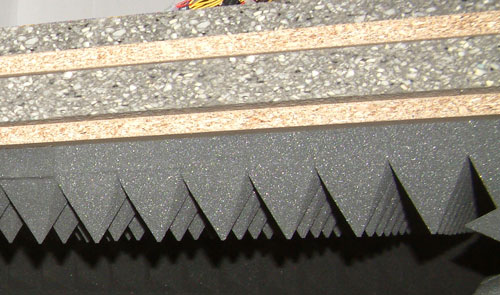
We concluded that a five-layer box with a total thickness of 6" (15cm) containing two layers of wood and three layers of special foam would suffice. It is designed as a box within a box. The inner box does not touch any part of the outer box, making it difficult for acoustic noise to pass through in the form of vibration. Each box is isolated on both sides with a layer of heavy foam that is normally used to insulate engines. On the inside we have an additional layer of 4" (10cm) thick pyramidal foam on every side of the box to eliminate the acoustic waves coming from the test object as well as we can.
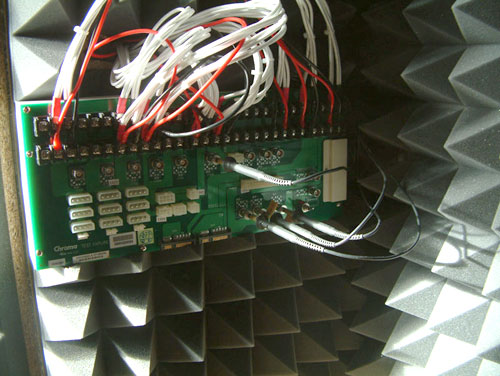
To ensure a completely closed system we installed the printed circuit board that the connectors of the power supply are attached to inside the anechoic room/box. In other box designs, you would need to put all the cables through the wall. Unfortunately, that would result in the inside of the box not being fully isolated anymore. Our design keeps everything that needs to be connected inside of the box and maintains isolation.
DC Output Stability and Quality

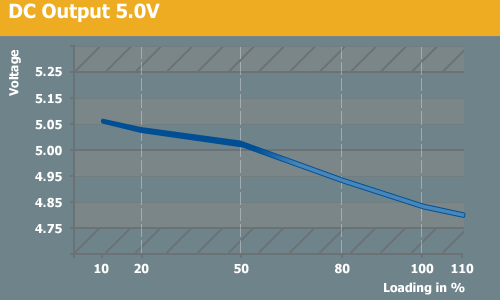


The 3.3V rail is a little unstable, with a low result of just 3.17V -- still within the specs but lower than we like to see. The 5V rail is similar, dropping very close to the lower limit of what is allowed; at 4.79V it is very close to falling out of spec. On the other hand, the 12V rail is very good, starting at 12.08V and only drop to 11.86V with 110% load. The 12V rail is by far the most important, and the overall voltage is good if not great.
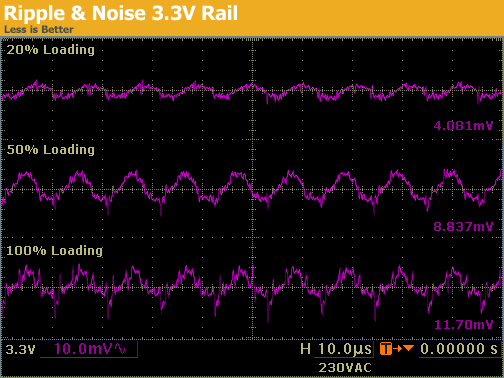
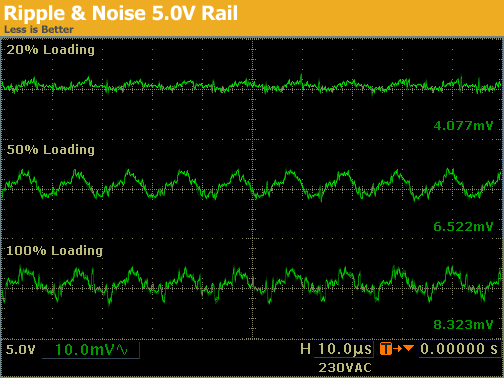
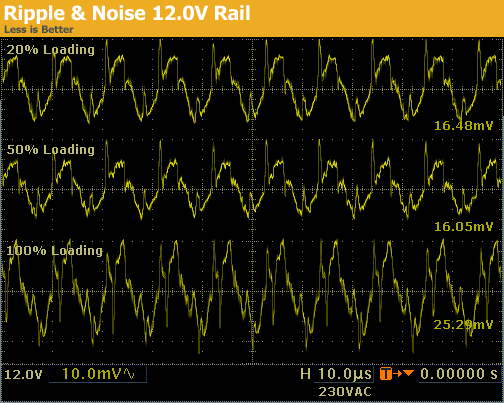
The ripple is higher than we expected from such a unit, showing the first real flaw. 25mV on the 12V rail is still nothing to worry about, but it is much higher than what we have tested with competing power supplies.
Efficiency and PFC
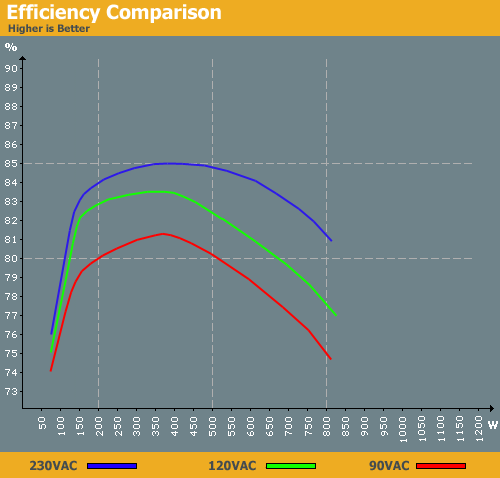
As mentioned already, we did not expect to see extremely high efficiency, since previous CWT manufactured power supplies generally top out at 85%. 230VAC reaches that same efficiency, but efficiency with lower input voltages is far worse, particularly in terms of the curve -- the 120VAC and 90VAC inputs both show a precipitous drop after around 400W. Differences between the three curves is rather startling, hitting two different recommendations for ideal loads. With 230VAC, you can easily run this power supply with anything from a 130W to a 700W load, which is a very large range. For 120VAC, the range shrinks to 130W to 500W for best efficiency. If you happen to use 90VAC, you would probably be best served by a different power supply, but you can at least get above 80% with a load of 200W to 500W.
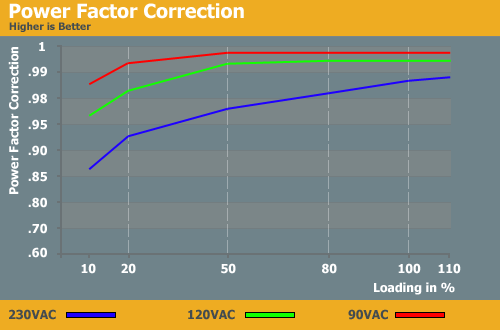
Power factor correction is always much higher with lower input voltages, but people in Europe will have to make do with only .97 at medium load. The PFC results for the TX750W are definitely worse than many of the other power supplies we've tested, particularly with 230VAC.
Temperatures, Fan Speed, and Acoustics

We really don't like CWT's heatsink design on their current power supplies, and the temperature readings show that our feelings are not without merit. The third heatsink reaches almost 80°C, which is quite hot for a modern power supply -- and this is running in a comfortable 25°C environment; imagine how hot the power supply would get with higher ambient temperatures. The result of higher temperatures is that the fan will need to run at maximum speed all the time. The exhaust temperature does stay relatively close to that of the first two heatsinks, which is good; that means they are doing a good job of transferring heat into the airflow and getting the heat out of the power supply. The problem is that the third heatsink has a temperature 20°C higher than the others.
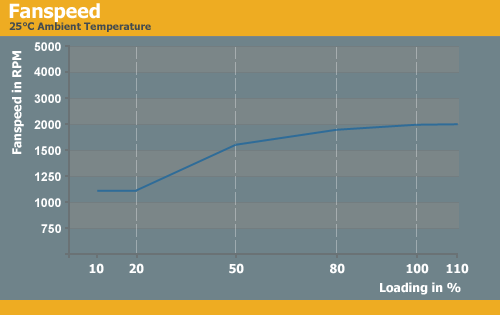
The fan spins at ~1100 RPM at lower loads of up to 20%. The fan begins spinning much faster at 50% load, even though temperatures are still reasonable. The first two heatsinks are only 10°C higher, so the dramatic ramp in fan speed shouldn't be necessary yet, but the fan is already spinning at around 1600 RPM. Maximum fan speed is reached at ~80% load, and it appears fan speed is being regulated by the temperature of the third heatsink as we can see above that the temperature is quite a bit higher.

The TX750W fan is not silent, and a moderate increase in fan speed results in a dramatic increase in noise levels. At minimal load, the power supply generates 21dB(A) of noise, which isn't terrible but it isn't great either -- you wouldn't normally notice the power supply when it's installed in a system at low loads. At 50% load the volume increases 7dB(A), which definitely becomes audible. You definitely do not want to run at anything near maximum load, however, as 80% load results in 39dB(A) and 100% load is 40dB(A)! If you are interested in silence (or even near silence), there are without doubt better power supplies.
Conclusion
The TX750W is second in command in Corsair's power structure, and it's not a bad product. However, we did have some concerns with this CWT-built power supply, and some of the results support those feelings.
The Corsair package and overall appearance is very well done. Buyers will certainly feel that they are getting a high quality product, and in fact the build quality is very good. The cables are nice and long, making this a great power supply for larger cases. The problem is that some of the internal design could be improved.
 |
We have already discussed the shape of the heatsinks, which we have seen in many other CWT-built power supplies. They simply aren't great for airflow, and it's odd because it shouldn't be too hard to change this aspect. All they need to do is leave a little more space between the fins, but this is a cheaper method of creating heatsinks. Still, Seasonic uses a similar method for some of their heatsinks and yet they still leave a larger gap between the fins, improving overall PSU temperatures. Another issue we saw with the internal design is that there's a large gap at the back of this PSU, since it has a large housing with a more normal sized PCB. The result is that we saw a lot of air circulating at the front of the power supply instead of being expelled out the rear, which may be one of the reasons for some of higher temperatures.
The tests also show that DC voltage regulation is not very tight and we saw large drops on almost every rail. The important 12V rail does best, but then it also has the highest ripple readings we've seen from a high-end power supply this year. Noise levels are also a negative, since the PSU is relatively loud even at lower loads, and anything above 80% load results in a very loud PSU.
Compared to other Corsair offerings, the TX750W is simply not up to snuff. The previously tested HX1000W was an excellent power supply, but that power supply uses a different topology. We also received an HX520W recently and that power supply performs very well -- it's a Seasonic-built unit. Pricing may be the one saving grace, however.
The TX750W has been in the market for a while, so the price is quite a bit lower than the MSRP. In the US, we have seen the TX750W for $100 to $130, which is a fair price for a 750W power supply. Prices in Europe start at €95, which equals $130 but includes tax. With an average price of $115, the Corsair TX750W is one of the cheapest 750W offerings on the market. The PC Power & Cooling Silencer 750 runs around $135 and the Cooler Master Real Power Pro costs $140. However, even with savings of $25 over some of the competition, there are plenty of other options in this price and performance range.

























